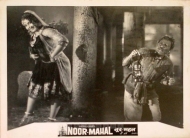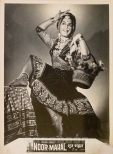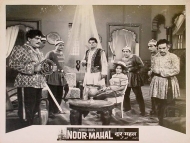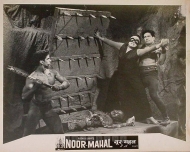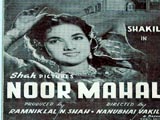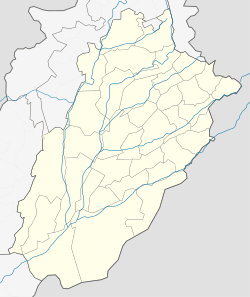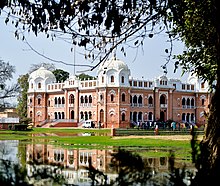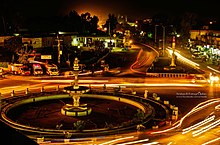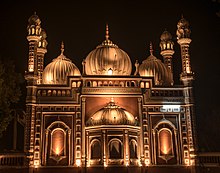film (Noor Mahal)(1965) Indian films and posters from 1930 ..no blog made
 Actor Photos
Actor Photos
 Hindi Movies Films Songs Books ... - 1953 Gul Sanobar
Hindi Movies Films Songs Books ... - 1953 Gul Sanobar
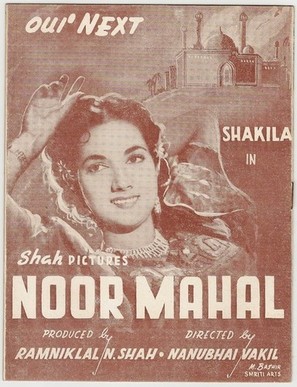

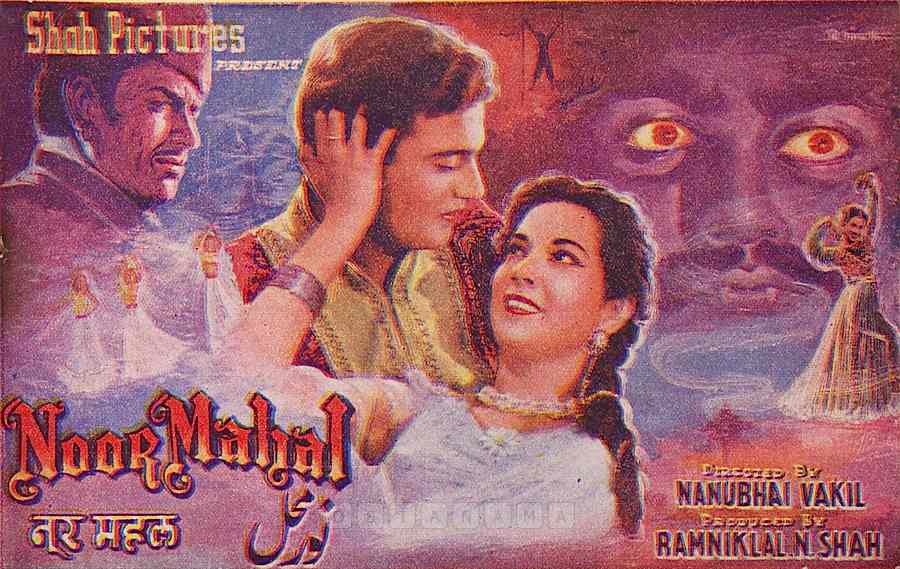


Noor Mahal is a story of a revenge taken by Vir Singh in greediness to get the throne of his brother who was the real king ...
Director : Noshir Engineer Producer : Ratan Kumar Writer : Ratan Kumar Music : Jaani Babu Qawwal Year : 1965 Cast : Chitra, ...
No songs -NO audio and NO video available
...............................................................................................................................
See also
Continue Reading...
| Noor Mahal | Nanubhai Vakil | Daljeet, Shakila, Kumkum, Kamal, Jagdish Kanwal, W. M. Khan | Fantasy | Music: A. R. Qureshi Lyrics: Munshi Dil |
Hindi Movies Films Songs Books

jagdish-kanwal
A.R. Qureshi - IMDb
A.R. Qureshi.
Composer | Music Department. + Add or change photo on IMDbPro ».
Contribute to IMDb. Add a bio, trivia, and more. Update information for
A.R. ...
 Actor Photos
Actor Photos
Actor Photos
Daljit
Married to Bengali singer Ashita Puri.
Also known as " Daljeet Puri".
Father of actor Satyajeet Puri and Deepali Isaar. 




NOOR MAHAL 1954
CINE 8
Noor Mahal (1954) ... Trending Hindi Movies and Shows ... Check out the Indian movies with the highest ratings from IMDb users, as well as the movies that are ...
Director:
Nanubhai VakilStars:
Daljeet, Jagdish Kanwal, W.M. Khan | See full cast & crew »Cast
| Credited cast: | |||
| Daljeet | |||
| Jagdish Kanwal | |||
| W.M. Khan | ... | (as Wazir Mohammed Khan) | |
| Kumkum | |||
| Shakila | |||
Edit
See full technical specs »
Details
Country:
IndiaLanguage:
HindiCompany Credits
Show more on
IMDbPro »
Technical Specs
Sound Mix:
MonoColor:
Black and WhiteWeb results
Complete information on bollywood movie: Noor Mahal Star cast, Movie Rating, Reviews, Plot, Screenshots, Song listing, Trailer, Watch Movie link and more...
Noor Mahal : Lyrics and video of Songs from the ... - HindiGeetMala
Mere Mehboob Na Ja, Aaj Ki Raat Na Ja.
| Browse Movie Titles (Alphabetically): 0-9 A B C D E F G H I J K L M N O P Q R S T U V W X Y Z | ||
| Yearwise: 2018 2017 2016 2015 2014 2013 2012 2011 2010s 2000s 1990s 1980s 1970s 1960s 1950s 1940s 1930s | ||
| Browse by Singer Name (Alphabetically): All A B C D E F G H I J K L M N O P Q R S T U V W X Y Z | ||
|
...............................................................................................................................
Search filters
Noor Mahal
...
The Noor Mahal(Urdu: نور محل) is a palace in Bahawalpur, Punjab, Pakistan. It was built in 1872 like an Italian chateau on neoclassical lines, now it is co-owned by Sajid Ali Isar And Malik Farhan at a time when modernism had set in. It belonged to the Nawabs of Bahawalpur princely state, during British Raj.[1]
History
There are various stories regarding its construction. According to one legend, Nawab Adnan Abbasi IV had the palace made for his wife; however, she was only there for one night, as she happened to see the adjoining graveyard from her balcony, and refused to spend another night there, and so it remained unused during his reign.[2]
Noor Mehal is one of the hidden gems of Bahawalpur, due to the lack of publicity. The palace is open to public. It is currently in the possession of the Pakistan Army and is used as a state guest house for holding state durbars and meetings with foreign delegations.
Architecture
The construction of Noor palace was undertaken by Nawab Sadiq Muhammad Khan the fourth, who was also known as the Shan Jahan of Bahawalpur for his passion of constructing beautiful buildings.
Mr. Heennan, an Englishman who was the state engineer, designed the building. The foundation of Noor Palace was laid in 1872. A map and coins of the state were buried in its foundation as a good omen. Most of the palace's materials and furniture were imported from England and Italy. The construction of the palace was completed in 1875 at a cost of Rs. 1.2 million. Considering the amount of silver in the Indian Rupee Coin at 11.66 Grams in 1862, this amount in 2016 would come to about 8.1 million US dollars. Noor Palace covers an area of 44,600 square feet (4,140 m2). It has 32 rooms including 14 in the basement, 6 verandas and 5 domes.[3]
The design encompasses features of Corinthian and Islamic styles of architecture with a tinge of subcontinental style. The Corinthian touch is visible in the columns, balustrade, pediments and the vaulted ceiling of Durbar Hall. The Islamic style is evident in the five domes, whereas the angular elliptical shapes are a stroke of subcontinent style. Nawab Muhammad Bahawal Khan the fifth added a mosque to the palace in 1906 at the cost of Rs. 20,000. The design is based on the mosque of Aitchison College.
In 1956, when Bahawalpur State was merged into Pakistan, the building was taken over by the Auqaf department. The palace was leased to the army in 1971; in 1997 the army purchased it for the sum of 119 million.
The building was declared a “protected monument” in September 2001 by the Government of Pakistan's Department of Archeology, and it is now open for general visitors, students trips and other interested persons.
Things to see
There are a lot of old things present in it. It includes many Nawabs' used things. There are many old swords, old currency notes and coins, old laws that were made in that time, an old piano that Nawabs used to play, old furniture used by Nawabs etc. There is also a long wall in it that contains imaginary pictures of Nawabs. Only one picture is real, all others are imaginary. There is also a prison cell aside the Mahal.
GallerySee also
| Wikimedia Commons has media related to Noor Mahal palace. |
- List of UNESCO World Heritage Sites in Pakistan
- List of forts in Pakistan
- List of museums in Pakistan
- Bahawalpur
- Bahawalpur State
Bahawalpur
بہاولپور
| ||
|---|---|---|

Clockwise from top: Noor Mahal Palace,Gulzar Mahal, Sadiq Dane High School, Darbar MahalPalace, Sadiq Mosque, Fareed Gate
| ||
| ||
| Coordinates: 29°23′44″N 71°41′1″ | ||
| Country | ||
| Region | ||
| District | Bahawalpur | |
| Tehsil | Bahawalpur City | |
| Union councils | 36 | |
| Government | ||
| • Type | Municipal Corporation | |
| • Mayor | Aqeel Najam Hashmi | |
| • Deputy Mayor | Malik Munir Iqbal Channar | |
| Area | ||
| • Total | 237.2 km2 (91.6 sq mi) | |
| Elevation | 181 m (702 ft) | |
| Population | ||
| • Total | 681,696 | |
| • Density | 2,900/km2 (7,400/sq mi) | |
| Time zone | UTC+5 (PKT) | |
| Postal code type |
63100
| |
| Area code(s) | 062 | |
| Bahawalpur / Punjab Portal | ||
Bahawalpur (بہاولپور), is a city located in the Punjab province of Pakistan. Bahawalpur is the 11th largest city in Pakistan with an estimated population of 798,509.[3][4]
Founded in 1748, Bahawalpur was the capital of the former princely state of Bahawalpur, ruled by the Abbasi family of Nawabs until 1955. The Nawabs left a rich architectural legacy, and Bahawalpur is now known for its monuments dating from that period.[5] The city also lies at the edge of the Cholistan Desert, and serves as the gateway to the nearby Lal Suhanra National Park.
Contents
History[edit]
Early[edit]
The area known as Bahawalpur was home to various ancient societies. The Bahawalpur region contains ruins from the Indus Valley Civilisation, as well as ancient Buddhist sites such as the nearby Patan minara.[7]British archaeologist Sir Alexander Cunningham identified the Bahawalpur region as home of the Yaudheya kingdoms of the Mahābhārata.[8][9] Prior to the establishment of Bahawalpur, the region's major city was the holy city of Uch Sharif - a regional metropolitan centre between the 12th and 17th centuries that it is renowned for its collection of historic shrines dedicated to Muslim mystics from the 12-15th centuries built in the region's vernacular style.[10]
Founding[edit]
Bahawalpur was founded in 1748 by Nawab Bahawal Khan I,[11] after migrating to the region around Uch from Shikarpur, Sindh.[12]Bahawalpur replaced Derawar as the clan's capital city.[13] The city had initially flourished as a trading post on trade routes between Afghanistan and central India.[14]
In 1785, the Durrani commander Sirdar Khan attacked Bahawalpur city and destroyed many of its buildings on behalf of Mian Abdul Nabi Kalhora of Sindh.[15] Bahawalpur's ruling family, along with nobles from nearby Uch, were forced to take refuge in the Derawar Fort, where they successfully repulsed attacks.[15] The attacking Durrani force accepted 60,000 rupees as nazrana tribute, though Bahawal Khan later had to seek refuge in the Rajput states as the Afghan Durranis occupied Derawar Fort.[15] Bahawal Khan returned to conquer the fort by way of Uch, and re-established control of Bahawalpur.[15]
Princely state[edit]
The princely state of Bahawalpur was founded in 1802 by Nawab Mohammad Bahawal Khan II after the break-up of the Durrani Empire, and was based in the city. In 1807, Ranjit Singh of the Sikh Empire laid siege to the fort in Multan, prompting refugees to seek safety in Bahawalpur in the wake of his marauding forces that began to attack the countryside around Multan.[15] Ranjit Singh eventually withdrew the siege, and gifted the Nawab of Bahawalpur some gifts as the Sikh forces retreated.[15]
Bahalwapur offered an outpost of stability in the wake of crumbling Mughal rule and declining power of Khorasan's monarchy.[15] The city became a refuge for prominent families from affected regions, and also saw an influx of religious scholars escaping the consolidation of Sikh power in Punjab.[15]
Fearing an invasion from the Sikh Empire,[16] Nawab Mohammad Bahawal Khan III signed a treaty with the British on 22 February 1833, guaranteeing the independence of the Nawab and the autonomy of Bahawalpur as a princely state. The treaty guaranteed the British a friendly southern frontier during their invasion of the Sikh Empire.[16]
Trade routes had shifted away from Bahawalpur by the 1830s, and British visitors to the city noted several empty shops in the city's bazaar.[14] The population at this time was estimated to be 20,000,[14] and was noted to be made up primarily of low-caste Hindus.[14] Also in 1833, the Sultej and Indus Rivers were opened to navigation, allowing goods to reach Bahawalpur.[15]
By 1845, newly opened trade routes to Delhi re-established Bahawalpur as a commercial centre.[15] The city was known in the late 19th century as a centre for the production of silk goods, lungis, and cotton goods.[17] The city's silk was noted to be of higher quality than silk works from Benares or Amritsar.[14]
An 1866 crisis over succession to the Bahawalpur throne markedly increased British influence in the princely state.[18] Bahawalpur was constituted as a municipality in 1874.[19] The city's Noor Mahal palace was completed in 1875.[13]In 1878, Bahawalpur's 4,285 foot long Empress Bridge was opened as the only rail crossing over the Sultej River.[13] Bahawalpur's Sadiq Egerton College was founded in 1886.[13] Bahalwapur's Nawabs celebrated the Golden Jubillee of Queen Victoria in 1887 in a state function at the Noor Mahal palace.[17] Two hospitals were established in the city in 1898.[13] In 1901, the population of the city was 18,546.[13]
Bahawalpur's Islamia University was founded as Jamia Abbasia in 1925. At the outbreak of World War II in 1939, Bahawalpur's Nawab was the first ruler of a princely state to offer his full support and resources of the state towards the crown's war efforts.[20]
Modern[edit]
British Princely states were given the option to join either Pakistan or India upon withdrawal of British suzerainty in August 1947. The city and princely state of Bahawalpur acceded to Pakistan on 7 October 1947 under Nawab Sadiq Muhammad Khan Abbasi V Bahadur.[21] Following independence, the city's minority Hindu and Sikh communities largely migrated to India en masse, while Saraiki Muslim refugees from India settled in the city and surrounding region. The city's Quaid-e-Azam Medical College was founded in 1971. While much of southern Punjab's Saraiki population in Multan support the Pakistan Peoples Party, the region around Bahawalpur is known for its support of the Pakistan Muslim League.[22]
Economy[edit]
The main crops for which Bahawalpur is recognised are cotton, sugarcane, wheat, sunflower seeds, rape/mustard seed and rice. Bahawalpur mangoes, citrus, dates and guavas are some of the fruits exported out of the country. Vegetables include onions, tomatoes, cauliflower, potatoes and carrots. Being an expanding industrial city, the government has revolutionised and libertised various markets allowing the caustic soda, cotton ginning and pressing, flour mills, fruit juices, general engineering, iron and steel re-rolling mills, looms, oil mills, poultry feed, sugar, textile spinning, textile weaving, vegetable ghee and cooking oil industries to flourish.[23]
Demographics[edit]
In 2007, the city's population was estimated to have risen to 798,509 from 403,408 in 1998.[3]No census has been conducted in Pakistan since 1998, although one will be completed in 2017. The Bakhri are a clan found in the Shabr Farid ilaqa of Bahawalpur claiming Rajput origin. They were previously converted to Islam but fearing to return to their Hindu roots they settled down in Multan as weavers.[24]
Religion[edit]
Bahawalpur emerged as a centre of Chisti Sufism following the establishment of a khanqa by Noor Muhammad Muharvi in the mid 18th century.[25] DeobandiIslamism was established in the Bahawalpur area during colonial times in an effort to counter the strong Sufi influence in the area. After Partition, a number of Deobandi institutions from Jalandhar and Ludhiana areas relocated to Pakistani Punjab, including to the cities of Multan and Bahawalpur.
Civic administration[edit]
Bahawalpur was announced as one of six cities in Punjab whose security would be improved by the Punjab Safe Cities Authority. 5.6 billion Rupees have been allocated for the project,[26] which will be modeled along the lines of the Lahore Safe City project in which 8,000 CCTV cameras were installed throughout the city at a cost of 12 billion rupees to record and send images to Integrated Command and Control Centres.[27]
Sports[edit]
Bahawal Stadium or The Bahawalpur Dring Stadium is a multipurpose stadium, home to Bahawalpur Stags. It hosted a sole international match, a test match between Pakistan and India in 1955.Motiullah hockey stadium is in Bahawal Stadium which is used for various national and international hockey tournaments in country. Aside from the cricket ground, it has a gym and a pool facility for the citizens.
Member Of Bahawalpur Assembly[edit]
Syed Charagh Shah S/O Syed Sarwar Shah Defender of Bahawalpur
Syed Sarwar Shah
See also[edit]
- Bahawalpur Museum
- Bahawalpur Zoo
- List of educational institutions in Bahawalpur
- List of people from Bahawalpur
References[edit]
- ^ "MC Bahawalpur". MC Bahawalpur. Retrieved 2018-04-25.
- ^ "DISTRICT AND TEHSIL LEVEL POPULATION SUMMARY WITH REGION BREAKUP: PUNJAB" (PDF). Pakistan Bureau of Statistics. 2018-01-03. Retrieved 2018-04-24.
- ^ a b Bahawalpur: Area & Population Archived 9 November 2010 at the Wayback Machine Official Bahawalpur Government Website, Retrieved 2009-09-17
- ^ Vandal, Sajida. "Cultural Expression of South Punjab" (PDF). UNESCO -





